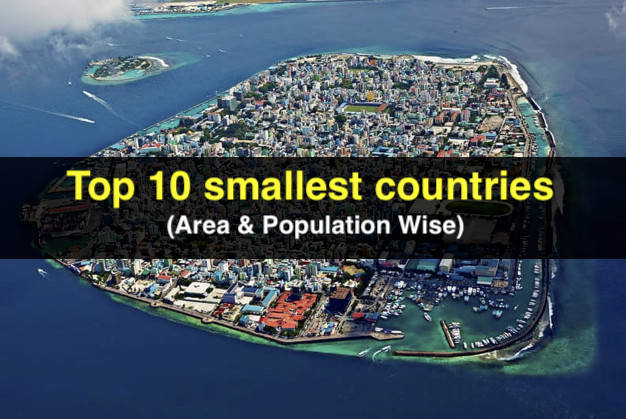Top 10 Smallest Countries (by Area Population)

The smallest country in the world can be positioned by which has the littlest populace or by which has the littlest all out land region. Albeit numerous nations that show up on one rundown will likewise show up on the other, the request will change contingent on which measurement is picked.
What is the littlest country on the planet by region?
The all out space of a nation alludes to how much region (both land and water) is incorporated by the nation’s boundaries. Regularly meant as far as miles squared or kilometers squared, its complete region is a mathematical worth of its actual size. Probably the biggest nations universally are Russia (6.59 million square miles), Canada (3.85 million square miles), and China (3.75 million square miles). Dissimilar to the populace, the complete space of nations normally doesn’t change over time.
Absolute region and populace size are regularly approximately associated—later allas the more noteworthy the region, the more individuals can fit onto it. In any case, the sort and environment of the land (sloping versus fields, swamps, deserts, and so forth), the advancement level (urban communities versus towns versus provincial) and capacity of the land (cultivating versus ranger service, fabricate, private, and so on) likewise have a critical effect upon the number of inhabitants in that land. In this manner, a country’s smallest country in the world with an enormous region isn’t ensured to have a monstrous populace, and a country with very little region might pack an amazing number of residents into that space.
Top 10 Smallest Countries in the World (by Total Area in km2/mi2) – 2021
- Vatican City – 0.49 km2/0.17 mi2
- Monaco – 2 km2/0.78 mi2
- Nauru – 20 km2/8.1 mi2
- Tuvalu – 30 km2/mi2
- San Marino – 60 km2/24 mi2
- Liechtenstein – 160 km2/62 mi2
- Marshall Islands – 180 km2/70 mi2
- Holy person Kitts and Nevis – 260 km2/101 mi2
- Maldives – 300 km2/116 mi2
- Malta – 320 km2/122 mi2
The smallest country in the world is Vatican City, which ranges over 0.19 square miles (mi2)/.49 square kilometers (km2). Super sumptuous Monaco comes in second with 0.78 mi2/2.02 km2, and San Marino right behind at 24 mi2/60 km2.
Note that this rundown incorporates just nations. Regions like Tokelau (New Zealand), Saint Barthélemy (France), and Macau (China) are equivalently little, yet not autonomous nations, and are in this manner ineligible.
What is the most un-populated country on the planet?
The littlest country on the planet as far as populace is Vatican City, which has around 800 residents. This is by a long shot the littlest populace of any nation, in spite of the fact that as in the past, a few domains approach:
- Tokelau (New Zealand region) – 1,373 individuals
- Niue (New Zealand domain) – 1,619
- Falkland Islands (UK domain) – 3,533
- Montserrat (UK domain) – 4,977
- Holy person Pierre and Miquelon (French an area) – 5,766
In any event, confining the rundown to just U.N.- perceived autonomous nations, there are as yet an amazing number of countries whose whole populaces are adequately little to squeeze into a football arena:
Top 10 Smallest Countries in the World (by Population)
- Vatican City – 800
- Nauru – 10,876
- Tuvalu – 11,931
- Palau – 18,169
- San Marino – 34,017
- Liechtenstein – 38,250
- Monaco – 39,511
- Holy person Kitts and Nevis – 53,544
- Marshall Islands – 59,610
- Dominica – 72,167
The evaluation and populace patterns in the United States
The principal US statistics was led on August 2, 1790, and is led at regular intervals. All in all, the Census Bureau of the United States of America plays out a decennial statistics. Before the authority decennial enumeration, there were comparable demonstrations of including the quantity of individuals in the US and recording the populace. These reports are remained careful by the National Archives and Records Administration of the USA.
The consequences of the United States’ enumeration offer an illustration of how a populace can shift and develop over the direction of a very long while:
Populace of the United States beginning around 1940:
- 1940 – 132,164,569 individuals
- 1950 – 151,325,798 individuals
- 1960 – 179,323,175 individuals
- 1970 – 203,302,031 individuals
- 1980 – 226,545,805 individuals
- 1990 – 248,709,873 individuals
- 2000 – 281,421,906 individuals
- 2010 – 308,745,538 individuals
- 2020 – 331,449,281 individuals
The latest United States Census is at present being led in 2020.
While most nations see populace development throughout the long term, a few countries are encountering populace decay. This is because of lower rates of birth (particularly in created nations, where youthful couples might focus on vocations over youngsters), negative net movement, and higher passing rates, especially as the post-WWII “gen X-er” age enters advanced age.





